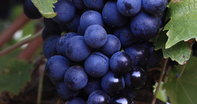
Description
Carignan is black skinned wine grape variety primarily used to produce blends and single varietal wines. The parentage of the variety is uncertain.Origins
The variety is originally from Spain, named after the town of Cariñena in the Aragon province. It has been produced in the Languedoc Roussillon region, which used to be part of the Catalunya-Aragon kingdom and became part of France in 1659, since the 12th Century.
The area under Carignan production in France has grown significantly over the years, while shrinking in Spain. The variety developed a negative reputation in the 1970s, when French farmers planted thousands of hectares of Carignan because of its high production capacity to cash in on Government aid which was based on production volumes.
The result was the production of billions of litres of poor quality Carignan wine. The area under production in France has been greatly reduced since the 1990s, due to government incentives, and there has also been a greater focus on the production of better quality Carignan wines.
Other Names
The variety is also knowns as Carignane in the United State, Carignano in Italy, Carignan noir in France and Tinto Mazuela or Samsó in Spain.Production in South Africa
Prof Abraham Izak Perold in the 1920s voiced his hope that Carignan production will be expanded in South Africa, due to the variety’s ability to thrive under dry climatic conditions. It seems that production only really started in the mid-1970s, with the Basson family, who farmed at Die Slot in Perdeberg planting one of the first vineyards in 1972. Charles Back of Fairview has established himself as one of the best producers of Carignan single varietal wines in the New World with his Pegleg Carignan, which is made from grapes of the bush vines at Die Slot. The wine is named after Cobus Basson who at the age of 17, lost his leg when a tractor overturned and rolled onto him while he was helping his father in the Carignan vineyard.Production Regions
The variety has small footprint in South Africa, with just over a hundred hectares planted in 2016. Most of these plantings are located in the Swartland, Paarl and Stellenbosch. The best Carignan wines seems to come from old bush vines of which production is limited.Growth and Ripening
The variety is a vigorous grower, with a high yield potential ranging between 15 t/ha to 20 t/ha. The grapes ripen from late mid-season, from the second half of March.
Berries and Leaves
The berries are black, round and of a small to medium size. The skin is hard and thick. Leaves are large, dark green, oblong and five lobed.